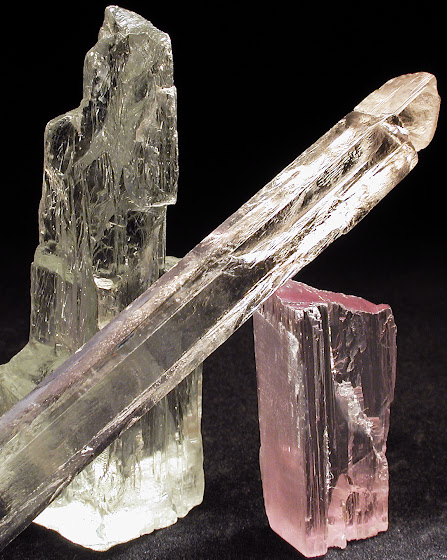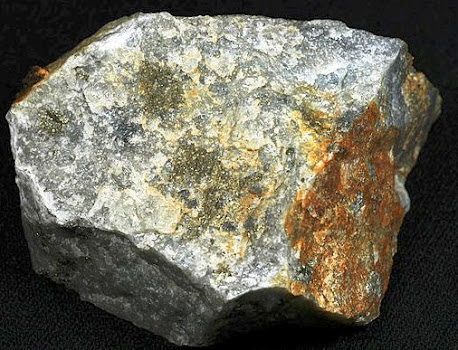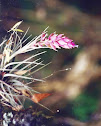MINERALS OF THE WORLD: SYSTEMATICS AND GEOLOGY..
_______________________________________________________
__________
Reference(s):
ATENCIO, D. Type Mineralogy of Brazil a book in progress. Instituto de Geociências USP: São Paulo, 2020, 662 pp.
IMA – The official IMA-CNMNC List of Mineral Names – Updated list of IMA approved minerals (March, 2025) http://cnmnc.main.jp/IMA_Master_List_%282022-11%29.pdf.
NEVES, P. C. P. das; CORRÊA, D. S.; CARDOSO, J. C. A classe mineralógica das combinações orgânicas associadas ao hidrogênio. Terra e Didatica, v. 4, n. 1, pp. 51-66, 2015.
NICKEL, E. H.; STRUNZ, K. H. Strunz Mineralogical Tables – Chemical Structural Mineral Classification System, Schweizerbart’sche Verlagsbuchhandlung: Sttutgart, 9th ed. 2002, 870 pp. (2010 – 10thed. – pending).
WARR, L. N. IMA-CNMNC approved mineral symbols. The Mineralogical Magazine, v. 85, n. 3, pp 291-320, 2021.
_______________________________________________________
__________
1. ABELLAITE (Abe) - NaPb2(CO3)2(OH)
Chemical data and Nickel-Strunz classes: molecular mass = 574.42 gmol 1-; elemental contents: Pb = 72.14%, O = 19.50%, C = 4.18%, Na = 4.00%, H = 0.18%; oxide contents: PbO = 77.72%, CO2 = 15.32%, Na2O 5.39%, H2O = 1.57%. Carbonates - 5.BE.X.
b) IMA status: validated species (2014).
Type-locality(ies):
 Eureka mine,
Castell-estaó, La Torre de Cabdella (Capdella), La Vall Fosca, El Pallars
Jussà, Lleida, Catalonia, Spain.
Eureka mine,
Castell-estaó, La Torre de Cabdella (Capdella), La Vall Fosca, El Pallars
Jussà, Lleida, Catalonia, Spain.Name origin:

Images:
D Genesis: secondary mineral that forms sparse coatings from supergene enrichment of a red-bad, sediment-hosted U-V-Cu deposit, may be associated with andersonite Na2Ca(UO2)(CO3)3.6H2O, calcite CaCO3, dolomite CaMg(CO3)2, galena PbS, natrolite Na2Al2Si3O10.2H2O, sanrománite Na2Ca
P Pb3(CO3)5, scolecite CaAl2Si3O10.3H2O, and seidite-(Ce) Na2
(Ce,Sr)2[TiSi8O18(O,OH)2](O,OH,F)4.5H2O. (IBAÑEZ-INSA et al., 2017).
OOccurrence(s): Russia and Spain (for more details, see Mindat.org in the page of mineral).
IBÁÑEZ-INSA, J.; ELVIRA, L. X.; PÉREZ-CANO, J.; ORIOLS, N.; BUSQUETS-MASÓ, M.; HERNÁNDEZ, S. Abellaite, NaPb2(CO3)2(OH), a new supergene mineral from the Eureka mine, Lleida Province, Catalonia, Spain. European Journal of Mineralogy, v. 29, n. 5, pp. 915-922, 2017.
_______________________________________________________
__________
2. ABELSONITE (Abl) - C31H32N4Ni
Chemical data and Nickel-Strunz classes: molecular mass = 519.31 gmol1-; elemental contents: C = 71.70%, Ni = 11.31%, C = 4.18%, N = 10.79%, H = 6.21%.
Organic Compounds - 10.CA.20.
b) IMA status: validated species (1975).
Type-locality(ies):
Repository(ies) (type-material): Natural History Museum, London, England (catalog(s): 1979-136); National Museum of Natural History, Washington, D. C., United States of America (catalog(s): 143,566; 145,712).
Name origin:
 in honor to American physicist, Prof. Dr. Philip Hauge Abelson (☼ Tacoma, 1913 - ┼ Bethesda, 2004), co-responsible for the discovery to the chemical element neptunium (Z = 93), editor of the journal Science (1962-1984), director of the Carnegie Institution and its Geophysical Laboratory (1953-1971), Washington, D. C., United States of America (Source: Wikipédia).
in honor to American physicist, Prof. Dr. Philip Hauge Abelson (☼ Tacoma, 1913 - ┼ Bethesda, 2004), co-responsible for the discovery to the chemical element neptunium (Z = 93), editor of the journal Science (1962-1984), director of the Carnegie Institution and its Geophysical Laboratory (1953-1971), Washington, D. C., United States of America (Source: Wikipédia).Crystal system: triclinic and crystalline structure (RRUFF Project).
D Genesis: secondary mineral generated under unique geochemical conditions by salts of organic acids, derived from chlorophyll diagenesis. Transport of the relatively insoluble precursor material was mobilized by aquous solutions to favorable sediments that occur along fractures of kerogen-rich shales, may be associated with albite Na(AlSi3O8), analcime Na(AlSi2O6).H2O, dolomite CaMg(CO3)2, orthoclase K(AlSi3O8), pyrite FeS2, and quartz SiO2.
Occurrence(s): United States of America (for more details, see Mindat.org in the page of mineral).
NEVES, P. C. P. das; CORRÊA, D. S.; CARDOSO, J. C. A classe mineralógica das combinações orgânicas associadas ao hidrogênio. Terrae Didatica, v. 4, n. 1, pp. , 51-66, 2015.
_______________________________________________________
__________
3. ABENAKIITE-(Ce) (Abk-Ce) - Na26(Ce,REE)6(SiO3)6(PO4)6(CO3)6 (S4+O2)O
Chemical data and Nickel-Strunz classes: molecular mass = 2,903.93 gmol1-; elemental contents: O = 34.71%, Ce = 28.95%, Na = 19.94%, P = 6.19%, Si = 5.63%, C = 2,41%, S = 2.17%; oxide contents: Ce2O3 = 33.89 %, Na2O = 27.73%, P2O5 = 14.11%, SiO2 = 12.41%, CO2 = 9.09%, SO2 = 2,77%.
Silicates (Germanates), Cyclosilicates, [Si6O18]12-6-membered single rings, with insular complex anions - 9.CK.10.
b) IMA status: validated species (1991).
Type-locality(ies):
Repository(ies) (type-material): Canadian Museum of Nature, Ottawa, Ontario, Canada (catalog(s): 81,501).
Name origin:
Images:
Crystal system: trigonal and crystalline structure (RRUFF Project).
Genesis: minerals that occur as xenoliths in sodalite syenite, as late-stage phases, possibly due to metasomatism (McDONALD et al., 1994).
Occurrence(s): Canada and Russia (for more details, see Mindat.org in the page of mineral).
McDONALD, A. M.; CHAO, G. Y.; GRICE, J. D. Abenakiite-(Ce), a new silicophosphate carbonate mineral from Mont Saint-Hilaire, Quebec: description and structure determination. The Canadian Mineralogist, v. 32, n. 4, pp. 843-854, 1994.
_______________________________________________________
__________
4. ABERNATHYITE (Abn) - K[(UO2)(AsO4)]H2O3
Chemical data and Nickel-Strunz classes: molecular mass = 520.11 gmol1-; elemental contents: U = 45.77%, O = 30.76%, As = 14.41%, K = 7.52%, H = 1.55%; oxide contents: UO2 = 81.92 %, As2O3 = 22.10%, H2O = 13.82%, K2O = 9.06%, CO2 = 9.09%, SO2 = 2.77%.
Arsenates - 8.EB.15.
b) IMA status: validated species (pre-IMA 1956).
Type locality(ies):
 Fumarola mine,
Temple Mountain, San Rafael mining district, Emery Co., Utah, United States of America.
Fumarola mine,
Temple Mountain, San Rafael mining district, Emery Co., Utah, United States of America.Repository(ies) (type-material): National Museum of Natural History, Washington, DC, United States of America (catalog(s): 112,650).
Name origin:
Images:
Crystal system: tetragonal and crystalline structure (Source: RRUFF Project).
Genesis: secondary mineral that fills fractures in asphaltic sandstones and, in the oxidation zone of uranium deposits, may be associated with arsenium As, heinrichite Ba(UO2)2(AsO4)2.10-12H2O, jarosite KFe3(SO4)2(OH)6, metazeunerite Cu2+(UO2)2(AsO4)2.8H2O, orpiment As2S3, pitticite [Fe3+,AsO4,SO4,H2O]?, realgar As4S4, scorodite Fe3+AsO4.2H2O and zeunerite Cu2+(UO2)2(As O4)2.10-16H2O.
Occurrence(s): France, Germany, Poland, South Africa Republic and United States of America (for more details, see Mindat.org in the page of mineral).
THOMPSON, M. E.; INGRAM, B.; GROSS, E. B. Abernathyite, a new uranium mineral of the metatorbernite group. The American Mineralogist, v. 41, ns. 1-2, pp. 82-90, 1956.
____________________________________________________
__________
5. 5. ABHURITE - (Abh) - Sn2+21O6(OH)14Cl14
Chemical data and Nickel-Strunz classes: molecular mass = 477.05 gmol1-; elemental contents: Sn = 74.77%, Cl = 14.86%, O = 10.06%, H = 0.42%; oxide contents: SnO = 84.71%, H2O = 3.78%, Cl = 14,86%, -O=Cl2 = -3,35%.
Halides - 3.DA.30.
b)IMA status: validated species (1983).
Type locality(ies):
Repository(s) (type-material): Ontario Royal Museum, Toronto, Canada; National Museum of Natural History, Washington, DC, United States of America (catalog(s): 162,403).
Name origin: in alusion of type-locality.
Images:
Crystalline system: trigonal and crystalline structure
g Genesis: Tin ingots corroded by sea water; usually as scabs on sunken ship hulls, may be associated with aragonite CaCO3, kutnohorite (Ca(Mn2+,Mg,Fe2+)(CO3)2, and romarchite SnO.
Occurrence(s): England and United Kingdown (Wales), Jamaica, Norway, Saudi Arabia, and United States of America (for more details, see Mindat.org in the page of mineral).
MATZKO, J. J.;
EVANS, H. T.; MROSE, M. E.; ARUSCAVAGE, P. Abhurite, a new tin hydroxychloride
mineral and a study a synthetic basic tin chloride. The Canadian Mineralogist, v. 23, n. 2, pp. 233-240, 1985.
_______________________________________________________
__________
6. ABRAMOVITE - (Abm) - Pb2SnInBiS7
Chemical data and Nickel-Strunz classes: molecular mass = 1,066.44 gmol1-; elemental contents: Pb = 37.30%, S = 20.35%, Bi = 17.44%, Sn = 12,13%, In = 11.41%.
Sulfosalts - 2.HF.25a.
b) IMA status: validated species (2006).
Type locality(ies):
f) Images:
Crystallline system: triclinic.
Genesis: in ingots corroded by sea water, may be associated with anhydrite CaSO4, galena PbS, halita NaCl, pyrrhotite Fe1-xS, pyrite FeS2, sylvite KCl, and wurtzite (Zn,Fe)S (YUDOSVSKAYA et al., 2008).
Occurrence(s): Russia (for more details, see Mindat.org in the page of mineral).
YUDOVSKAYA, M. A.; TRUBKIN, N. V.; KOPORULINA, E. V.; BELAKOVSKY, D. I.; MOKHOV, A. D.; KUSZNETSOVA, M. V.; GOLOVANOVA, T. I. Abramovite, Pb2SnInBiS7, a new mineral species from fumaroles of the Kudryavy volcano, Kurile islands, Russia. Geology of Ore Deposits, v. 50, n. 7, pp. 551-555, 2008.
_______________________________________________________
__________
6. 7. ABSWURBACHITE - (Abs) - CuMn3+6(SiO4)8
Chemical data and Nickel-Strunz classes: molecular mass = 809.485 gmol1-; elemental contents: Mn = 40.70%, Si = 27.74%, O = 23,71.29%, Cu = 7.85%; oxide contents: Mn2O3 = 58.48%, SiO2 = 31.70%, CuO = 9.82%.
Silicates (Nesosilicates) - 9.AG.05.
b) IMA status: validated species (1990).
Type locality(ies):
 Mili, Dirfys-Messapia, Euboea, Central Greece; Apikia, Vasiliko Mountain, Andros, South Aegea, Greece.
Mili, Dirfys-Messapia, Euboea, Central Greece; Apikia, Vasiliko Mountain, Andros, South Aegea, Greece.f) Images:
Crystallline system: tetragonal.
g)Genesis: in in very low-grade, high pressure metamorphic quartzites, may be associated with clinochlore Mg5Al(Si3O10)(OH)8, hollandite Ba(Mn4+6Mn3+2)O16, piemontite (CaCa)(AlAlMn3+)O][Si2O7][SiO4](OH), quartz SiO2, rutile TiO2, shattuckite Cu2(SiO3)4(OH)2, surssasite Mn3+Al3(SiO4)(Si2O7)(OH)3 and tenorite CuO (REINECK et al., 1991).
REINECK, T.; TILLMANNS, E.; BERNHARDT, H. J. Abswurmbachite, Cu2+Mn3+6[O8/SiO4] a new mineral of the braunite group: natural occurrence. Synthesis and crystal structure. Neues Jahrbuch für Minerálogie, Abhandlugen, v. 163, pp. 117-143, 1991.
_______________________________________________________
__________
8. ABUITE - (Abu) - CaAl2(PO4)2F2
Chemical data and Nickel-Strunz classes: molecular mass = 321.98 gmol1-; elemental contents: O = 39.75%, P = 19.24%, Al = 16,76%, Ca = 12.45%, F = 11,80%; oxide contents: P2O5 = 44,08%, Al2O3 = 31,67%, CaO = 17,42%, F = 11,80%, -O=F2 = 4,97%.
Phosphates - 8.BO.
b) IMA status: validated species (2014).
Type locality(ies):
f) Images:
Crystallline system: orthorhombic.
g)Genesis: in hydrothermally altered, felsic pyroclastic rocks, related to a biotite adamellite intrusion, may be associated with "apatite", augelite Al2(PO4)(OH)3, crandallite CaAl3(PO4)(PO3OH)(OH)6, quartz SiO2, and trolleite Al4(PO4)3(OH)3 (ENJU; UCHARA, 2017).
ENJU, S.; UCHARA, S. Abuite, CaAl2(PO4)2F2, a new mineral from the Hinomaru-Nago mine, Yamaguchi Prefecture, Japan. Journal of Mineralogy and Petrolology Sciences, v. 112, n. 1, pp. 109- 115, 2017.
_______________________________________________________
__________
8. 9. ACANTHITE - (Aca) - Ag2S
Chemical data and Nickel-Strunz classes: molecular mass = 247.80 gmol1-; elemental contents: Ag = 87.60%, S = 12.94%.
Sulfides - 2.BA.35.
b) IMA status: validated species (pré-IMA 1855).
Type locality(ies):
f) Images:
Crystallline system: monoclinic and crystalline structure.
g)Genesis: a common silver species in moderately low-temperature hydrothermal sulphide veins, and in zones of secondary enrichment, may be associated with aguilarite Ag4SeS, calcite CaCO3, chalcopyrite CuFeS2, galena PbS, polybasite [Ag9CuS4][(Ag,Cu)6(Sb,As)2S7], proustite Ag3SbS3, pyrargyrite Ag3SbS3, quartz SiO2, silver Ag, Al2(PO4)(OH)3, sphalerite ZnS, and stephanite Ag5SbS4 (PALACHE et al., 1944).
PALACHE, C.; BERMAN, H.; FRONDEL, C. Dana’s system of mineralogy, (7th ed.), v. I, pp. 191–192 (acanthite), pp. 176–178 (“argentite”).
_______________________________________________________
__________
10. ACETAMIDE - (Ace) - CH3CONH2
Chemical data and Nickel-Strunz classes: molecular mass = 59.07 gmol1-; elemental contents: C = 40.67%, O = 27,09%, N = 23.71%, H = 8.53%.
Organic Compounds - 10.AA.20
b) IMA status: validated species (1974).
Type locality(ies):
f) Images:
Crystallline system: Trigonal and crystalline structure.
g)Genesis: in burning waste coal heaps, formed between 50°C and 150°C., may be associated with salammoniac NH4Cl (SREBRODOL'KII, B. I. , 1975).
SREBRODOL'KII, B. I. (1975) Acetamide CH3CONH2 – a new mineral. Zapiski. Vserossyskogo Mineralogicheskogo Obshchestva, v. 104, n. 3, pp. 326–328, 1975.
c)
c)








































Comentários
Postar um comentário